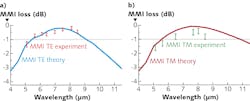Photonic Integrated Circuits: Wideband integrated mid-IR Mach-Zehnder interferometer looks good for spectroscopy

Numerous photonic applications are based on the use of light in the mid-infrared (mid-IR) spectral region, including forms of free-space optical communications that take advantage of the 3–5 and 8–13 μm atmospheric transparency windows, and a varied and important range of spectroscopic techniques used to analyze organic substances with absorption bands in the so-called fingerprint region of 2 to 20 μm.
Mid-IR optical instrumentation is typically based around bulk optical systems, which work well, but can be large, complex, and expensive. Applications in the mid-IR, and spectroscopy in particular, could benefit from the miniaturization of optical systems achieved by transforming them into photonic integrated circuits (PICs).
Many mid-IR PIC components have been designed and demonstrated, made of various optical materials such as chalcogenide glass, germanium on silicon (Ge on Si), silicon on sapphire, germanium on silicon nitride, and others. These components include wavelength multiplexers, arrayed waveguide gratings, ring resonators, Mach-Zehnder interferometers (MZIs), and others—but none of these have had a functional mid-IR wavelength range of more than 1 μm, and thus aren't truly broadband.
Now, researchers at Université Paris Saclay (Orsay, France) and Politecnico di Milano, Polo di Como (Como, Italy) have broken the 1 μm bandwidth barrier by creating an integrated mid-IR waveguide MZI that has a 3 μm spectral operating range.1 The device has a higher-than-10-dB extinction ratio over the entire 3 μm, and consists of Si0.2Ge0.8 waveguides fabricated on a graded Si1-xGex substrate.
The researchers chose to use a Si1-xGex alloy because not only does the material allow great control of the bandgap, refractive index, light confinement, and dispersion, but Ge is transparent out to 15 μm-meaning that if the alloy is Ge-rich, long mid-IR wavelengths may be accessible.
Possibility of longer wavelengths
The Si1-xGex substrate, which is grown via low-energy plasma-enhanced chemical-vapor deposition, has a Ge concentration that varies from 0 to 0.79 over an 11 μm thickness. On top of this is grown a 2-μm-thick Si0.2Ge0.8 guiding core layer. Next, 4-μm-wide waveguides comprising the different experimental Mach-Zehnder interferometers are defined by etching 4 μm deep into the structure, allowing good confinement of both TE and TM fundamental modes. Although the geometry results in a multimode interference (MMI) structure, the interferometers' input and output MMI waveguides are tapered to ensure that only the fundamental mode is coupled over the entire 3 μm spectral operating range.
Three different 9.4-mm-long MZIs were characterized, with path-length differences of 48, 87, and 149 μm, respectively. For experimentation, a pulsed mid-IR tunable external-cavity quantum-cascade laser (MIRcat) with a 5% duty cycle, a peak intensity of 300 mW at a 6.5 μm wavelength, and a 100 kHz pulse repetition rate was incoupled to the device. The tuning range of the MIRcat was 5.5–8.5 μm. A mercury cadmium telluride (MCT) detector was used to characterize the device's output. (Bulk zinc selenide aspheric lenses were used for incoupling and outcoupling.)
The measured waveguide propagation losses were lower than 5 dB/cm for both polarizations across the 3 μm wavelength range-the measured transmission was actually relatively flat across the range (see figure). The researchers attribute the broadband properties of the MZIs to the low vertical confinement and the vertical refractive index gradient in the graded Si1-xGex substrate.
The researchers note that numerical simulations of the configuration show that it should be possible to extend the spectral operating range of the MZI 9 μm for TE polarization and 11 μm for TM polarization.
REFERENCE
1. V. Vakarin et al., Opt. Lett. (2017); https://doi.org/10.1364/ol.42.003482.
About the Author
John Wallace
Senior Technical Editor (1998-2022)
John Wallace was with Laser Focus World for nearly 25 years, retiring in late June 2022. He obtained a bachelor's degree in mechanical engineering and physics at Rutgers University and a master's in optical engineering at the University of Rochester. Before becoming an editor, John worked as an engineer at RCA, Exxon, Eastman Kodak, and GCA Corporation.
